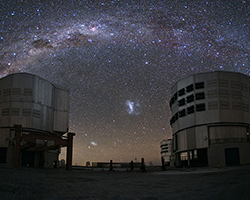
Dwarf Galaxies
While large galaxies take on the shapes like elliptical and spiral, there is another group for small galaxies. These galaxies are known as dwarf galaxies. How much smaller are these galaxies? Well, the Milky Way has about 200 billion stars but dwarf galaxies have around 100 million stars. That’s still a huge number! So let’s look at it a different way; for every one star in a dwarf galaxy there are 2,000 stars in the Milky Way.
 These smaller galaxies are typically found orbiting larger galaxies, much like the way moons orbit planets. Astronomers believe that they form when galaxies collide with one another. As they collide, a group of stars gets ripped off of a larger galaxy, forming a dwarf galaxy.
These smaller galaxies are typically found orbiting larger galaxies, much like the way moons orbit planets. Astronomers believe that they form when galaxies collide with one another. As they collide, a group of stars gets ripped off of a larger galaxy, forming a dwarf galaxy.
Dwarf galaxies can be grouped by shape just like the larger galaxies. Because most of them come from galaxy collisions, many dwarf galaxies are grouped into the irregular shape. However, some dwarf galaxies have spiral arms or look like mini-elliptical galaxies
Our galaxy is orbited by more than 20 dwarf galaxies. Two of the largest of them are called the Large Magellanic Cloud and the Small Magellanic Cloud. They are both named after the explorer Ferdinand Magellan (1480-1521) who first saw them while sailing from Spain towards South America. The Large Magellanic cloud looks like a mini-spiral galaxy while the Small Magellanic Cloud is classified as an irregular galaxy.
Additional images via Wikimedia Commons. Spiral dwarf galaxy 4625 by ESA/Hubble.

Dwarf galaxies are their own category of small galaxies, but within that group, you can also have different shapes, like this spiral dwarf galaxy.
Be Part of
Ask An Earth and
Space Scientist
By volunteering, or simply sending us feedback on the site. Scientists, teachers, writers, illustrators, and translators are all important to the program. If you are interested in helping with the website we have a volunteers page to get the process started.
